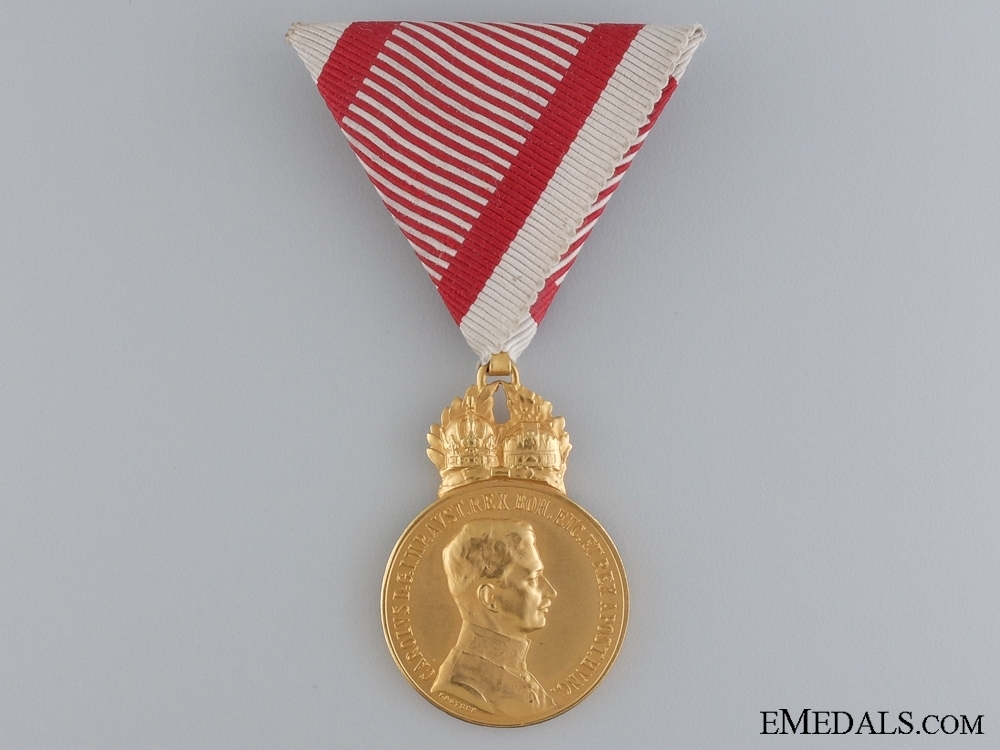Military Merit Medal "Signum Laudis", Karl I, Bronze Medal (Military Ribbon)
CATEGORY: Version
SKU: 02.AUT.0119.203.01.002
Estimated market value:

Estimated market value:
The Military Merit Medal was created by Emperor Franz Joseph I instituted in 1890. It was awarded to military officers for “Laudatory recognition for outstanding achievements in wartime” or “satisfaction with excellent services in peacetime.”
The medal was designed by Prof. Anton Scharff on the obverse and engraver Andreas Neudeck on the reverse. In wartime the medal was awarded for excellent military achievements, and in peacetime the medal was awarded for outstanding services that benefited Austria and the Emperor. This medal was worn on the Austrian wartime ribbon, or a plain red ribbon for Non-Combatants (civilians). The original Bronze Medal was awarded to Officers.
In 1982, it was decided that individuals who had been awarded “laudatory recognition’ from Feldmarschall Count Wenzel Radetzky during the 1848-1849 would receive the medal on a military ribbon.
On March 26, 1911 the medal was amended and a silver grade was added to reward repeated meritorious actions. The medal was amended again by a Royal decree on April 1, 1916 which added a Gold Medal grade, and clasps to the Silver Medal's ribbon for further repeated acts of merit.
If the Silver Medal was awarded for a second time, one clasp is added to the ribbon. If the Silver Medal was awarded for a third time, two clasps are added to the ribbon. From 1917-1918 the ribbon may feature crossed swords for recipients that had direct contact with the enemy.
When Karl I ascended the throne, the medal was altered with his portrait and inscription. In April 1917, onward the surmounting crown was changed to a double crown to symbolically represent the Austrian Empire and the Kingdom of Hungary. It was permitted for recipients to wear the Franz Joseph I model if they were awarded they medal for a second time.
It is unfortunately not possible to identify the number of awards conferred prior to the First World War due to the lack of award statistics. During the war, the Bronze Military Medal with/without swords became the common decoration for subaltern officers with the fighting troops. More than 300 silver medals were awarded between 1914 and 1918.
Due to the increased need for the medals, many private companies and manufacturers began producing the medal using a variety of materials (often resulting in a poor-quality portrait of the Emperor). A conscious effort was made in 1917 to ensure that high quality production was taking place, as the Government issued a decree warning against the purchase or creation of medals made from ‘inferior’ metal. At the end of the First World War, the Military Merit Medal ceased to be awarded.
The wartime ribbon had a stripe of red and white on both sides of the centre, while the centre area featured thin alternating horizontal stripes of red and white. The peacetime ribbon for non-combatants was plain red.
The obverse presents a left facing portrait of the reigning emperor, and the reverse presents a wreath of laurel and oak leaves around the inscription SIGNUM LAVDIS.
Due to the addition of the Silver and Gold Medal grades, later issued examples of the Bronze Medal were awarded to lower rankings military personnel.

Comments
Sign in to comment and reply.


Scroll Top